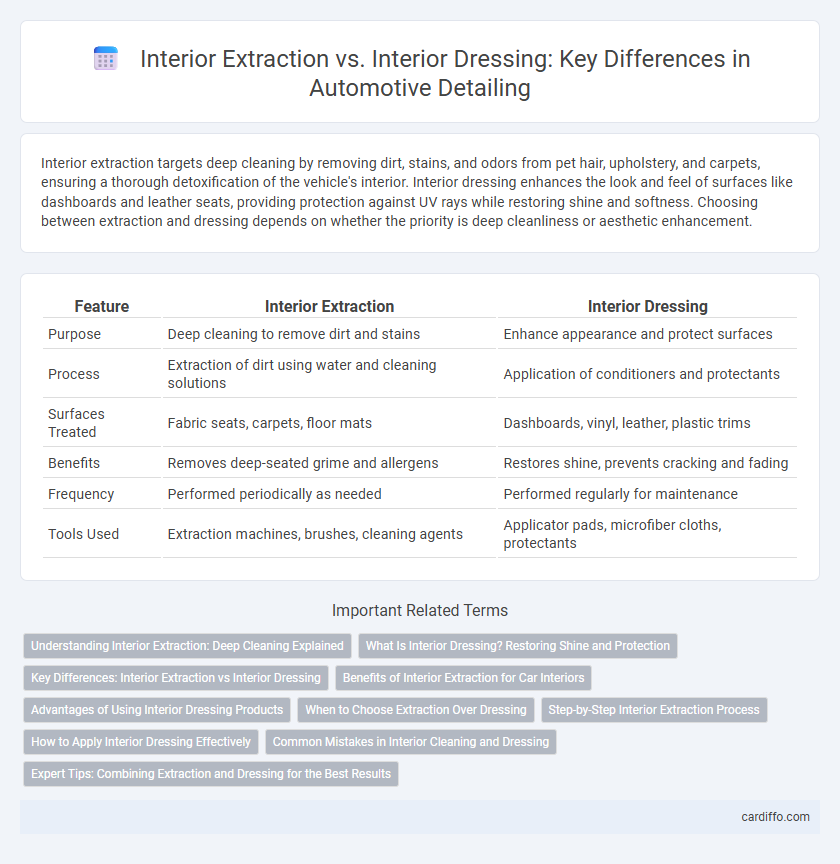Interior extraction targets deep cleaning by removing dirt, stains, and odors from pet hair, upholstery, and carpets, ensuring a thorough detoxification of the vehicle's interior. Interior dressing enhances the look and feel of surfaces like dashboards and leather seats, providing protection against UV rays while restoring shine and softness. Choosing between extraction and dressing depends on whether the priority is deep cleanliness or aesthetic enhancement.
Table of Comparison
| Feature | Interior Extraction | Interior Dressing |
|---|---|---|
| Purpose | Deep cleaning to remove dirt and stains | Enhance appearance and protect surfaces |
| Process | Extraction of dirt using water and cleaning solutions | Application of conditioners and protectants |
| Surfaces Treated | Fabric seats, carpets, floor mats | Dashboards, vinyl, leather, plastic trims |
| Benefits | Removes deep-seated grime and allergens | Restores shine, prevents cracking and fading |
| Frequency | Performed periodically as needed | Performed regularly for maintenance |
| Tools Used | Extraction machines, brushes, cleaning agents | Applicator pads, microfiber cloths, protectants |
Understanding Interior Extraction: Deep Cleaning Explained
Interior extraction, a deep cleaning method, uses specialized machines to inject cleaning solutions into fabric or carpet fibers and simultaneously extract dirt, grime, and allergens. This process reaches deep beneath the surface, removing embedded contaminants that regular vacuuming or light cleaning cannot address. Interior extraction enhances air quality, extends the lifespan of upholstery, and restores the vehicle's interior to a near-new condition.
What Is Interior Dressing? Restoring Shine and Protection
Interior dressing involves applying specialized products to car surfaces such as dashboards, door panels, and trim to restore shine and provide a protective barrier against UV rays, dust, and wear. This process enhances the aesthetics of materials like vinyl, leather, and plastic while preventing fading, cracking, and discoloration over time. Unlike interior extraction, which deep cleans the upholstery, interior dressing focuses on maintaining surface appearance and prolonging material durability.
Key Differences: Interior Extraction vs Interior Dressing
Interior extraction involves deep cleaning techniques such as shampooing carpets, steam cleaning upholstery, and removing embedded dirt and stains to restore fabric and surfaces inside a vehicle. Interior dressing, by contrast, focuses on applying protective and enhancing coatings to dashboards, leather seats, and plastic trims to improve appearance and prevent damage from UV rays and wear. The key difference lies in extraction's emphasis on intensive dirt removal, whereas dressing prioritizes surface conditioning and aesthetic enhancement.
Benefits of Interior Extraction for Car Interiors
Interior extraction deeply removes embedded dirt, allergens, and stains from car upholstery and carpets, improving air quality and enhancing overall comfort. This process extends the lifespan of interior fabrics by preventing mold, mildew, and deterioration caused by trapped moisture and contaminants. Regular interior extraction maintains the vehicle's resale value by preserving a fresh, clean, and odor-free environment.
Advantages of Using Interior Dressing Products
Interior dressing products enhance vehicle aesthetics by restoring and protecting surfaces such as dashboards, door panels, and trim with long-lasting shine and UV resistance. These products help prevent cracking, fading, and discoloration, maintaining the interior's value and appeal. Their easy application and quick drying time optimize detailing efficiency compared to traditional interior extraction methods.
When to Choose Extraction Over Dressing
Choose interior extraction over interior dressing when deep cleaning is required to remove embedded dirt, stains, and odors from upholstery, carpets, and fabric surfaces. Extraction uses high-pressure hot water and powerful vacuuming to lift contaminants from deep within fibers, making it ideal for heavily soiled interiors or after long periods without cleaning. Interior dressing is better suited for adding protective coatings and enhancing the appearance of cleaned surfaces rather than thorough contaminant removal.
Step-by-Step Interior Extraction Process
Interior extraction involves a meticulous step-by-step process beginning with vacuuming all surfaces to remove loose debris, followed by shampooing carpets and upholstery to eliminate deep-seated dirt and stains. Steam cleaning is then applied to sanitize hard surfaces and fabric, ensuring bacteria and allergens are effectively removed. The process concludes with thorough drying and conditioning of leather or vinyl components to maintain material integrity and enhance the vehicle's interior appearance.
How to Apply Interior Dressing Effectively
To apply interior dressing effectively, start by thoroughly cleaning and vacuuming all surfaces to ensure the dressing adheres properly without trapping dirt. Use a high-quality, non-greasy dressing product applied evenly with a microfiber cloth or applicator pad, focusing on dashboards, door panels, and trim to restore a natural, matte finish while preventing dust accumulation and cracking. Allow the dressing to cure for several minutes, avoiding over-application to maintain a clean, long-lasting interior that enhances the vehicle's overall appearance.
Common Mistakes in Interior Cleaning and Dressing
Common mistakes in interior extraction include using excessive water, which can lead to mold growth and fabric damage, and neglecting to thoroughly vacuum before extraction, resulting in trapped dirt that reduces cleaning effectiveness. In interior dressing, improper application of products like conditioners or protectants can cause sticky residues or discoloration, while failing to allow adequate drying time often leads to unpleasant odors or streaking. Ignoring manufacturer guidelines for both cleaning agents and dressing materials often compromises the longevity and appearance of vehicle interiors.
Expert Tips: Combining Extraction and Dressing for the Best Results
Expert tips for interior detailing emphasize combining extraction and dressing techniques to achieve optimal results by thoroughly removing dirt and deep-seated stains before applying protective coatings. Extraction uses advanced steam or hot water methods to lift contaminants from fabrics, carpets, and upholstery, while dressing restores and enhances surfaces by conditioning and adding a protective layer that maintains cleanliness and appearance. This dual approach ensures deep cleaning and long-lasting protection, significantly improving the interior's overall freshness and durability.
Interior Extraction vs Interior Dressing Infographic

 cardiffo.com
cardiffo.com